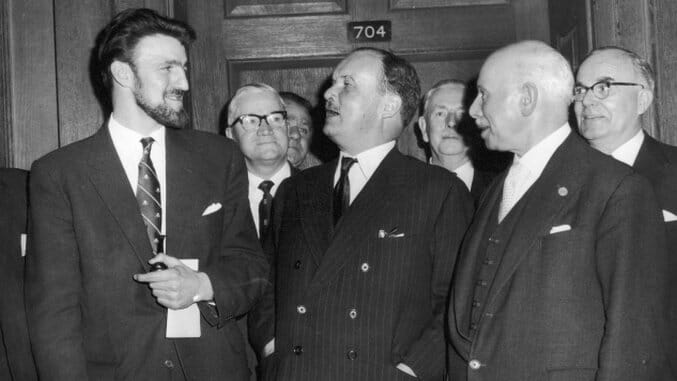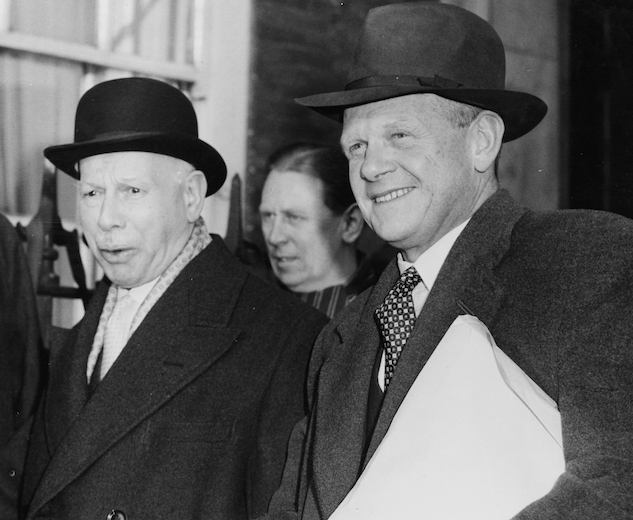Throwback Thursday: English Football Abolishes The £20 Wage Cap (January 18th, 1961)
Photo by Edward Miller/Getty Soccer Features Football
When reading the backpages about the blockbuster deals surrounding the likes of Gareth Bale, Luis Suárez, and Raheem Sterling, it’s easy to forget that there was a time when things were very different for professional footballers. Those who make the game what it is used to ply their trade under conditions that no one would tolerate today: unsafe working conditions, no job security, no protection or safety net should something terrible happen, no leverage in contract negotiations, and, of course, relatively little pay. Until the middle of the 20th Century, “professional footballer” was practically a contradiction in terms.
Yet things did get better for footballers over time, thanks to stronger organization and a willingness by more and more players to stand up for what any working stiff wanted— a living wage.
This week, we look back 55 years on one of the biggest advances in professional football: the end of the £20 wage cap in English football.
The story of better pay for footballers is tied to what is now known as the Professional Footballers’ Association. It formed a few years after a scandal in English football in which Manchester City defender Di Jones cut his knee on broken glass during a preseason friendly. The wound became infected and Jones ultimately succumbed to blood poisoning and lockjaw.
Back then, football still hewed to the principles of “amateurism,” that athletes should only compete for love of the game and to uphold Victorian and Edwardian values. This had a number of consequences for what was by the turn of the century a primarily working class pool of players, the most obvious being that it was difficult to make a living solely by playing football. (By the time of Jones’ death, the average wage for Football League players was £4 a week, which amounted to less than £500 a week in today’s figures.) But another hitch was that since players weren’t “working,” clubs argued that they didn’t have the kind of obligations to the players that, say, a factory would have toward its workers. That’s exactly how Manchester City argued their way out of assuming liability for Jones’ death, and with no insurance in place, his wife and kids were left penniless.
Within five years, Jones’ teammate Billy Meredith helped form what would one day become the PFA, eager to ensure that what happened to Jones wouldn’t happen to any more of his colleagues. Over the decades, the trade union helped exert upward pressure on wages, and by World War II footballers were making slightly more than average workers. Yet the trend started to reverse during the 40s and 50s, despite the influx of revenue from both the advent of television and European competition. Between the Football League’s maximum wage cap of £20 a week, the lack of a safety net for players who suffer injury or demotion to the reserves, and the retain-and-transfer system— which allowed clubs to hold on to the rights of a player even after their contract expired, making sure that they couldn’t move freely to another club— players felt increasingly under the thumb of clubs profiting from their labor.
So, in January 1961, the players did what any band of workers would do. They called a strike.

With a consensus of players ready to walk off the job, a strike action was scheduled for Saturday the 21st. The clubs’ resolve had started to weaken, with chairman arguing among themselves whether the wage cap was still worth the trouble it was causing and wealthier clubs positioning themselves to poach players from other squads with the promise of higher wages. Union leaders from other industries urged the public not to attend matches that went ahead with scab players.
Three days before the strike, the League forced the clubs to agree to concessions. Initially, the PFA did not call off the strike, hoping instead to press the advantage and try to get retain-and-transfer repealed as well. Ultimately, PFA officials met with club chairmen at the Ministry of Labour in London, and while they did not get retain-and-transfer repealed, the wage cap was gone.
Later that year, Fulham inside forward Johnny Haynes signed a new deal paying £100 a week, making him the most high-profile beneficiary of the post-wage cap football landscape.
The events of January 1961 marked the beginning of more and more lucrative deals for players, initially providing comfortable living wages and then, in the Premier League era, making many professional footballers very wealthy. The retain-and-transfer system remained a problem for players but, with the Bosman ruling in 1995, that too ultimately fell by the wayside. Players in England now have plenty of leverage in negotiating with their clubs, and thanks to the efforts of the players’ trade union in 1961 can be paid whatever the market will bear— and as it turns out, the market can bear quite a lot.
Of course, some will say that player wages have experienced an overcorrection, and that there’s something unseemly about 20 and 21 year old boys earning upwards of £200k per week. And maybe they’re right. But they would also do well to remember Di Jones, earning barely enough to put food on the table and, when an accident due to unsafe working conditions took his life, left his family with nothing. Say what you will about the largesse as seen with Raheem Sterling and Memphis Depay— it sure beats the alternative.